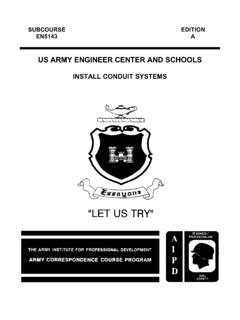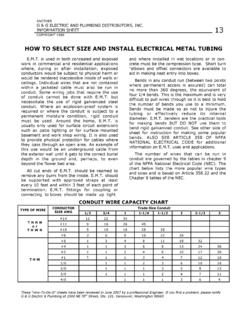Transcription of Conduit Bender Guide - GRID Alternatives
1 1 Arrow Uses: Stub-up, Offset and outer marking of saddle bends. Star Point Uses: Back bends. Angle Marks Uses: Offset, saddle bends and various installation situations Stub Height Uses: Number to use for Bender take-up. Conduit Bender Guide Conduit bending Basics: The line of Klein Tools Conduit benders have been designed for performance and durability exceeding the expectations of today s professional. It is recommended to familiarize yourself with bending concepts, techniques and learn the Bender s functionality to provide you a positive experience while greatly improving the overall outcome of your project. Conduit come in two types, EMT and Rigid conduits and can be found in various sizes. Klein Tools provides Conduit benders for EMT in , , 1 and 1- Conduit and , , and 1 Rigid Conduit .
2 To aid bending when performing a ground or air bend, the benders are marked with different alignment symbols to help the operator create the bends necessary to accomplish any project. The symbols found on the Klein Tools benders are the arrow, the teardrop, the star point and angle markings. These markings are found on various sides of the Bender head. The 4 most common bends to know how to make are the 90 Stub-Up, Back to Back, Offset and the 3 Point Saddle bends. It is common to use a combination of the Bender markings when making certain tube profiles. Knowing the proper technique and method of making the bends will allow you to accomplish most projects efficiently. Things to remember while bending : 1.
3 A proper bend is made by rolling the Conduit about the Bender in the Conduit s cradle using all foot pressure. 2. Use the correct size Bender for the Conduit size being bent. 3. Some over bending may be required to allow for spring back of the Conduit . The resting condition of the Conduit is to be at the final angle desired. 4. Measure and properly mark your Conduit using the tables and information provided. 5. Floor bending : Make sure Conduit is secure so it does not slide prior to bending . Apply ample foot pressure to the benders heel while minimizing the use of the handle as a lever but more of a Guide . 6. Air bending : Make sure handle s hilt is secure on ground and is reinforced by your foot so it does not slide out.
4 Make sure you are balanced and apply force close to the tool and your body controlling the tubing as you bend it around the Bender s cradle making sure the Conduit does not slide in the Bender head. 7. To prevent injury, always wear protective gear and do not over exert. Center of Bend Rim Notches Uses: Locates the center of a saddle bend. Klein Tools Ductile Iron Series: EMT: #56203 EMT: #56204 1 EMT: #56205 1- EMT: #56211 Klein Tools Aluminum Series: EMT: #56206 EMT: #56207 2 90 Stub-Up Bend: The stub bend is made by bending a piece of Conduit into an L shape or 90 bend by placing the free end (short end) of the tube to a predetermined length as indicated in the diagram below. This is the most common bend and is a building block for other bends.
5 Common uses for this bend are: Running Conduit into electrical boxes, running Conduit up or down walls, running Conduit into walls through floors and ceilings and making inner and outer corner turns. 1. Determine the overall free end height of the Conduit you want after the bend. 2. From the overall free height, subtract the stub height listed in the Bender Take-Up Table for the Conduit size you are bending . Klein Tools has provided the correct stub height on each Bender head. 3. On the Conduit , measure from the free end to be bent up the calculated number and mark the Conduit . As an example, to bend 3/4 EMT Conduit have a free end height of , the table indicates to subtract 6 from the which leave from the end to bend up to make the mark.
6 Tip: Advanced benders can lay a tape measure next to the Conduit and perform the bending operations if the bend does not call for high degree of accuracy. 4. Always use the proper size Conduit Bender for the Conduit size being bent. The Conduit will not bend properly and/or will be damaged if a mismatch of Bender and Conduit size is used. Place the Bender onto the tubing with the hook pointed towards the free end to be bent upwards. Make sure the Conduit is resting properly in the Bender s hook and lineup the arrow symbol with the mark you placed on the tubing . Bender Take Up Table 90 Stub-Up Bend Conduit Size Stub Height Amount to subtract from Measurement EMT 5 EMT and Rigid 6 1 EMT and Rigid 8 1- EMT and 1 Rigid 11 3 5.
7 Keeping the Conduit flat, apply ample foot pressure to the Bender s heel minimizing the use of the handle as a lever, rolling up the free end into the 90 position checking the degree with a level. When done properly the free end will be at the desired height and the arrow will be at the stub height as indicated. In some installations there will be a need to cut down the unbent side of the Conduit to another desired length to fit the installation. Use a tube cutter for smooth precise cutting and burr removal to ensure the safety of the electrical wiring when pulled through. A hacksaw can be substituted as long as the tubing s cut edge is prepared properly. Klein Tools Tube Cutter: #88975 & 88977 Klein Tools Hacksaw: #701-10, 701 -12 &701 -S Klein Tools Level: #931-6RE & 931-7RE 4 Back to Back Bends: The back to back bend is the next style of bend that is needed while running electrical Conduit .
8 In reality the concept is formulated by the need to know the distance from the back edge of a 90 bend to a fixed point down the Conduit to mark for other bend operations to meet the installation requirement. As you will see it builds on the 90 stub bend and when done the most common use of this bend will look like an elongated U. You will need to know this bend method when you want to fit Conduit between two parallel surfaces such as two walls or joists while keeping the U s outer edges of the legs touching the two surfaces. This allows for proper anchoring and a nice clean appearance. 1. Determine the distance between the two parallel surfaces to get the dimension for back to back bend. 2. The first bend for the back to back bend is the 90 stub-up bend.
9 Follow the steps from the 90 Stub-Up section to create the ideal bend for the connection on the first side. 3. From the back edge of the 90 stub-up bend, measure the distance found in step 1 and make your mark on the Conduit . 4. Place the Bender on the Conduit with the Bender s hook facing the free end of the tube to be bent opposite the original bend side. Make sure the Conduit is resting properly in the Bender s cradle and lineup the Star Point Symbol with the mark you placed on the tubing . 5 5. Keeping the Conduit flat, apply ample foot pressure to the Bender s heel, with minimal use of the handle as a lever, rolling up the free end into the 90 position checking the degree with a level. It is very important to keep the first 90 bend in the same plane as the new bend.
10 If not the two legs of the U will be skewed and will not produce the desired shape. If this happens, some correcting can be done to properly align the legs depending on how out of shape they are. When the bend is done properly the Conduit will lay flat and will fit inside the two surfaces measured. In some installations there will be a need to cut down the unbent side of the Conduit to another desired length to fit the installation. Use a tube cutter for smooth precise cutting and burr removal to ensure the safety of the electrical wiring when pulled through. A hacksaw can be substituted as long as the tubing s cut edge is prepared properly. Klein Tools Tube Cutter: #88975 & 88977 Klein Tools Hacksaw: #701-10, 701 -12 &701 -S Klein Tools Level: #931-6RE & 931-7RE If the back to back distance is short (a tight U) so the Bender has problems fitting to make the second bend, you may compensate by subtracting the stub height from the measured distance to fit the gap then follow step 3 to mark the calculated number on the Conduit .










